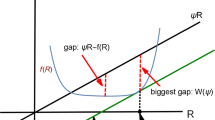Summary
The objective of this paper is to discuss some implications of a scalar theory of gravitation developed in a previous paper. At the beginning we shall show that, on the basis of a scalar theory of gravitation, it is possible to predict a gravitational light drag. The remainder of this paper is devoted to cosmology. We shall prove that Hubble's red-shift, the existence of an age and an «effective radius» of the Universe can be deduced from a model of universe that is Euclidean, infinite and nonexpanding. Finally, we discuss briefly Olbers' paradox and the thermal evolution of the Universe.
Riassunto
Scopo di questo lavoro è discutere alcune implicazioni di una teoria scalare di gravitazione sviluppata in un lavoro precedente. Dapprima si mostra che, sulla base di una teoria scalare di gravitazione, è possibile prevedere un «light drag». Il resto del lavoro è dedicato alla cosmologia. Si prova che lo spostamento nel rosso di Huble, l'esistenza di un'età e di un «raggio efficace» dell'Universo possono essere dedotti da un modello di Universo che è euclidiano, infinito e non in espansione. Infine si discute brevemente il paradosso di Olbers e l'evoluzione termica dell'Universo.
Резюме
В этой статье обсуждаются некоторые следствия скалярной теории гравитации, развитой в предыдущей статье. Сначала мы показываем, что на основе скалярной теории гравитации можно предсказать гравитационное «торможение света». Затем мы обсуждаем проблемы космологии. Мы доказываем, что красный сдвиг Хаббла и существование возраста и «эффектного радиуса» Вселенной можно получить из модели Вселенной, которая является эвклидовой, бесконечной и не расширяется. В заключение, мы вкратце обсуждаем парадокс Олберса и тепловую эволюцию Вселенной.
Similar content being viewed by others
References
J. A. Ferrari:Foundations for a theory of gravitation, inNuovo Cimento B,78, 53 (1983).
No particular (exclusive) property of static gravitational fields is used to derive this conclusion.
In the general case, the transformation equation for lengths could be obtained by using the principle of superposition.
SeeN. Rosen:Phys. Rev.,57, 150 (1940). In his words, «… We cannot carry out a Lorentz transformation in the presence of a gravitational field, but must first get rid of the latter by going over to a suitable system in which the componentsg μν [of the metric tensor] are constant (at least for a small portion of space), we can always make a further co-ordinate transformation so as to give them their special relativity values. But then no light-drag or “ether-drift” can be observed».
The Fizeau experiment was originally proposed byN. Rosen as an attempt (not rather satisfactory) to explain the well-known results ofD. C. Miller (Rev. Mod. Phys.,5, 203 (1933)) on the «ether drift», and not as a decisive experiment for a scalar theory of gravitation.
M. Berry:Principles of Cosmology and Gravitation (Cambridge University Press, Cambridge, 1976), p. 175.
In some respects this resembles the conclusions obtained through Nordström's theory of gravitation (seeS. S. D. Willembrock:Am. J. Phys.,50, 229 (1982)). Then it is not possible to establish the numerical value of the upper limit for the time interval between the beginning and the end of the Universe. At present, Nordström's theory of gravitation is considered unviable since it predicts no bending of light and a retrograde precession of (Mercury's) perihelion (see, for example,G. J. Whitrow andG. E. Morduch:Vistas in Astronomy, Vol.6 (Pergamon Press, Oxford, 1965)), p. 1.
S. Weinberg:Gravitation and Cosmology (J. Wiley & Sons, New York, N. Y., 1972), Chapt. 14.
See, for example, eq. 14.6.4. inS. Weinberg:Gravitation and Cosmology. Those «Kinematical relations» are used to determine the observational value ofq 0 in an indirect way.
Author information
Authors and Affiliations
Additional information
Traduzione a cura della Redazione.
Переведено редакцией.
Rights and permissions
About this article
Cite this article
Ferrari, J.A. Scalar gravitation and cosmology. Nuovo Cim B 82, 192–202 (1984). https://doi.org/10.1007/BF02732872
Received:
Published:
Issue Date:
DOI: https://doi.org/10.1007/BF02732872




